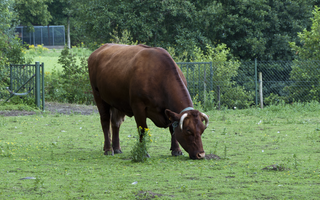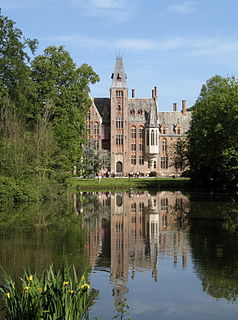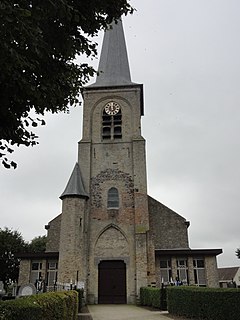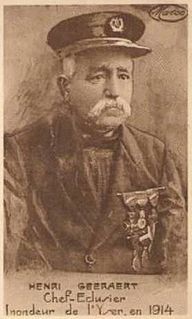Related Research Articles

West Flanders is the westernmost province of the Flemish Region, in Belgium. It is the only coastal Belgian province, facing the North Sea to the northwest. It has land borders with the Dutch province of Zeeland to the northeast, the Flemish province of East Flanders to the east, the Walloon province of Hainaut in the southeast and the French department of Nord to the west. Its capital is Bruges (Brugge). Other important cities are Kortrijk in the south and Ostend (Oostende) on the coast, Roeselare and Ypres (Ieper). The province has an area of 3,197 km2 (1,234 sq mi) which is divided into eight administrative districts (arrondissementen) containing 64 municipalities. As of January 2019, West Flanders has a population of 1,195,796.

Veurne is a city and municipality in the Belgian province of West Flanders. The municipality comprises the town of Veurne proper and the settlements of Avekapelle, Booitshoeke, Bulskamp, De Moeren (Belgium), Eggewaartskapelle, Houtem, Steenkerke, Vinkem, Wulveringem, and Zoutenaaie.

Cassel is a commune in the Nord départment in northern France. Built on a prominent hill overlooking French Flanders, the town has existed since Roman times. It was developed by the Romans into an important urban centre and was the focus of a network of roads, which are still in use today, that converge on the hill. After the fall of the Roman Empire, Cassel became an important fortified stronghold for the rulers of Flanders which was repeatedly fought over before finally being annexed to France in the 17th century. It was the headquarters of Marshal Ferdinand Foch during part of the First World War. In 1940, during the German invasion of France, Cassel was the scene of a fierce three-day battle between British forces and German forces which resulted in much of the town being destroyed.

The Flemish peasant revolt of 1323–1328, sometimes referred to as the Flemish coast uprising in historical writing, was a popular revolt in late medieval Europe. Beginning as a series of scattered rural riots in late 1323, peasant insurrection escalated into a full-scale rebellion that dominated public affairs in Flanders for nearly five years until 1328. The uprising in Flanders was caused by both excessive taxations levied by the Count of Flanders Louis I, and by his pro-French policies. The insurrection had urban leaders and rural factions which took over most of Flanders by 1325.

The Treaty of Aix-la-Chapelle or Aachen ended the War of Devolution between France and Spain. It was signed on 2 May 1668 in Aachen. Spain acceded on 7 May 1669.

Theresa of Portugal was Countess of Flanders by marriage to Philip I, Count of Flanders, and Duchess of Burgundy by marriage to Odo III, Duke of Burgundy. She was the daughter of the Portuguese king Afonso I and Matilda of Savoy. She served as co-regent of Portugal with her brother during the illness of their father Afonso I of Portugal from 1172 until 1173, and regent of Flanders during the interim period after the death of her spouse and the accession of his heir.

The Belfries of Belgium and France are a group of 56 historical buildings designated by UNESCO as a World Heritage Site, in recognition of the civic belfries serving as an architectural manifestation of emerging civic independence from feudal and religious influences in the former County of Flanders and neighbouring areas which once were possessions of the House of Burgundy.

The Belgian Red is a cattle breed from Flanders in Belgium and Northern France. It is considered in danger of extinction.
Furnes may refer to:

Loppem Castle is a mansion situated in Loppem in the municipality of Zedelgem, near Bruges in West Flanders, in the Flemish Region of Belgium.

Westhoek or Maritime Flanders is a region in Belgium and France and includes the following areas:
- Belgian Westhoek including the West Flanders arrondissements of Diksmuide, Ypres, and Veurne including the cities of Veurne, Poperinge, Wervik, Ypres, De Panne, Langemark-Poelkapelle, Diksmuide and Koekelare. However, the three Belgian coast municipalities of De Panne, Koksijde, and Nieuwpoort are frequently considered a separate region known as the Belgian or Flemish West Coast.
- French Westhoek, roughly the arrondissement of Dunkirk, including the cities of Dunkirk, Gravelines, and Hazebrouck, itself part of a larger area known as French Flanders.
Florent Robert Frans Brouw is a Belgian pianist. He became a Canadian citizen in 1975.

Jules Vanhevel was a Belgian racing cyclist. He was a professional from 1919 to 1936.

Vlamertinge is a village in the Belgian province of West Flanders and a borough of the city of Ypres. The village center of Vlamertinge lies just outside the city center of Ypres, along the main road N38 to the nearby town of Poperinge.

Hoogstade is a village in the municipality of Alveringem in the Belgian province of West Flanders. The village is located on the N8. Until 1971, Hoogstade was an independent municipality.
The first edition of the Tour of Flanders, a cycling race in Belgium, was held on 25 May 1913. Paul Deman won the event in a five-man sprint before Joseph Van Daele and Victor Doms. The event was created by sports journalist Karel Van Wijnendaele and organized by sports newspaper Sportwereld.

Fort Knokke or Fort de Cnocke or Fort de la Knocque or Fort de Knocke was an important fortification that defended western Flanders from the 1580s until it was demolished in the 1780s. During its 200 year history, the place was held by the Spanish Empire, Kingdom of France, Habsburg Austria and the Dutch Republic. The existing defenses were improved in 1678 by the famous military engineer Sébastien Le Prestre de Vauban. The fort was attacked by the Grand Alliance in 1695 during the Nine Years' War but the French garrison successfully held out. It was captured from the French by a ruse in 1712 during the War of the Spanish Succession. Control of the fort and other strong places in the Austrian Netherlands was a key feature of the so-called Barrier Treaty in 1713. The French captured the fort after a two-month siege in 1744 during the War of the Austrian Succession. Emperor Joseph II had the citadel demolished in 1781. The site is on the Yser River about 8 kilometres (5 mi) southwest of Diksmuide, Belgium.

Hendrik Geeraert was a Belgian folk hero who, during the interwar period, came to symbolize the Belgian resistance movement against the German forces in World War I. He became famous among Belgian soldiers in 1914 after the Battle of the Yser where he, serving as a Nieuwpoort skipper, opened the sluices of the Yser River, flooding the polders and bringing the German advance to a halt.

The Ganzepoot is a series of locks and spillways in the inner port of Nieuwpoort, Belgium which connect one river, three water channels and two canals with the mouth of the Yser River and the maritime port. The spillways control the level of the two channels and the drainage of the polders.

Pieter Bladelin was an important financial advisor and civil servant to the Burgundian State. He was lord of Middelburg and built the Hof Bladelin in Bruges.
References
- ↑ In the city of Veurne's center, the name Landhuis (literally: 'country-house') was given assumedly because it served the countryside – as opposed to the adjacent Stadhuis (literally: 'city-house' though always meaning the City Hall) that served the city.